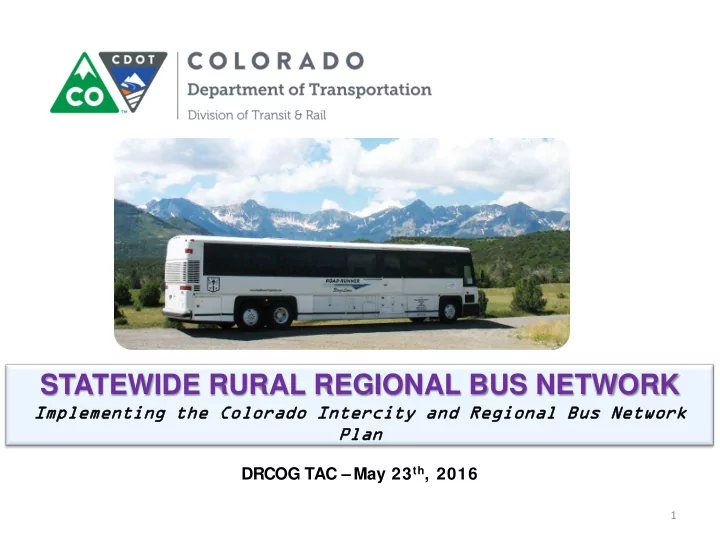

STATEWIDE RURAL REGIONAL BUS NETWORK Impl pleme ementi nting ng the C Colora lorado do Inter ercit city a y and R d Regio iona nal B l Bus Netwo work rk Pla Plan May 23 th , 2016 DRCOG TAC – 1
DIVISION OF TRANSIT AND RAIL • CDOT Role o DTR receives and manages $32M annually for capital, operating & administration the State’s transit infrastructure o Administers $1.6M in Federal money for rural and intercity transit operations o Administers $1.0M in FASTER operating grants. • DTR’s role/mission Plan… .Operate… .Build o Coordinate State and local transit services o Manage limited dollars to maximize opportunities at State & local o levels. 2
DIVISION OF TRANSIT AND RAIL (Cont) • Colorado’s First Statewide Transit Plan o Element in the Statewide Transportation Plan developed by the TPR’s o Identified projects that: Increase intermodal transit connectivity Make transit more time-competitive with the automobile Maximize mobility needs and system efficiency Reduce VMT and greenhouse gas emissions • 2014 Statewide Intercity and Regional Bus Network Plan Identified statewide goals for development, stations and o connectivity needs of the Rural Regional network Identified policy, performance and financing issues o Defined preferred networks for intercity and regional bus o networks. 3
RURAL REGIONAL STATEWIDE BUS NETWORK MISSION Develop a statewide network of private and public services that addresses both regional & intercity trip needs Uses existing and new services (where possible) Offers convenient regional mobility between urban and rural areas, and with connections to the national and international locations. Based on what we learned through the ICB Network Study and SW Transit Plan. 4
RURAL REGIONAL BACKGROUND • In 2004 the intercity bus companies like Greyhound began shedding over 2,500 rural stops nationwide affecting 8.4 million rural residents in an effort to cut losses; states west of the Mississippi River were affected the most. • To ease the impact under SAFETEA-LU, FTA implemented a pilot program that allowed ICB Companies (Greyhound) to provide unsubsidized capital or operating miles as “in-kind” match toward the local match to entice operators to reinstate the lost rural service. Now codified in F AS T ACT o • FAST Act continues the Federal policy of requiring 15% of FTA 5311 program dollars go to support intercity bus services for rural areas 2016 - $1.65M is available for Colorado annually o • Current Challenges in Colorado Long distances and inconvenient schedules for the travelling public o Lack of common or well-aligned brand o Cost of Capital is often “ operationalized” , thereby making the service o more expensive. Lack of connectivity between rural parts of the state and activity centers o 5
A BETTER SOLUTION: “The Washington State Model” • In 2007 WSDOT launched a distinctive solution branded Travel Washington Identified and prioritized the routes with S tatewide RTPO & MPO assistance. o Purchased the fleet o Allocated 5311(f) funds through a competitive bid process, rather than a o grant selection process, to fund services on routes that the department identified through its planning processes. Meets all conditions of meaningful ICB connections and has broad FTA support o • The Colorado Rural Regional Bus Network will mimic the WSDOT project in order to enhance the existing network Create a more competitive environment to get the best performance out of o limited dollars. Costs savings will go to expanding the network over time. o Addresses multiple markets and needs that aren’ t met today o Enhanced connectivity to the intercity bus network Addresses regional travel needs for day trips to regional center 6
CREATING THE MOST EFFECTIVE NETWORK Will require: • Considerations of both markets: Intercity Bus & regional services • Understanding scheduling & operating constraints Greyhound o Bustang o Proposed CO Rural Regional statewide services o Locally operated regional services o • Maximize local funding and Greyhound “in-kind” match • Other means of supporting multiple markets – subsidized and profitable routes Fares & Ticketing o Customer information o • Routes will need to be prioritized due to funding constraints 5311(f): approx. $1.65m available annually o F AS TER Regional Operating assistance: approx. $500k available o 7
Unsubsidized ICB Network 8
RURAL REGIONAL OPERATED BY LOCAL TRANSIT AGENCIES 9
Current Subsidized Network 10
Proposed Basic Rural Regional Network 11
Proposed Basic Rural Regional Network With Regional Services 12
Potential Expansion of Basic Rural Regional Network 13
Policy Areas to Explore with Stakeholders • Scheduling What level of service is needed in these corridors? 3 days a week? 5? 7? o Does a trip provide adequate time at regional centers – five hours? Four o hours? Are schedules meaningful and convenient? o Can we maintain connections with Greyhound within desired/ required o window? • Fares S hould we work to build a system that maximizes farebox recovery or that o maximizes ridership by using lower fares? What type of fare medium should be employed? What role would ticket o agents have? What role should equity considerations play? o S hould there be a threshold or cap for maximum subsidy amount? o How important should connections to local transit systems be in the o decisions? 14
NEXT STEPS o S pring 2016: collaborate with TPR’s and MPO’s to gather input on policy questions and finalize the routes o S ummer 2016: S eek Transportation Commission approval o S ummer 2016: Begin to develop a bus specification o Fall 2016 / Winter 2017: procure the fleet of OTR small coaches with S B-228 funds o Calendar Y ear 2017: Develop S ervice Contracts o Calendar Y ear 2018: Implement the Rural Regional Network 15
Questions? Michael Timlin Bus Operations Unit 4201 East Arkansas Ave Rm 227 Denver, CO 80222 (303) 757-9648 16
Recommend
More recommend